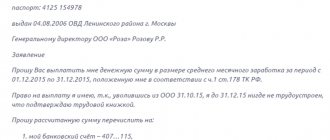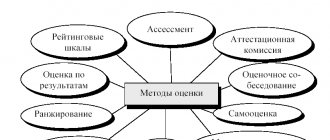Home / Labor Law / Personnel Management / Personnel training and certification
Back
Published: 08/16/2016
Reading time: 8 min
0
2245
To increase the efficiency of employees, the employer uses various methods of motivation and incentives, which can be both material and intangible.
The practice of many enterprises shows that it is material motivation that is the most effective, but also quite costly from a financial point of view . Therefore, the concept, types and specific methods of this type of employee incentives are worth considering in more detail.
- The concept of material motivation
- Types of motivation Motivation through rewards
- Motivation through punishment
what employees need
If you ask any person, especially a manager from the 90s, what is the essence and types of employee motivation, the answer will be more or less predictable - increasing productivity using “carrots and sticks”.
The stick usually means fines (standard 300-1000 rubles for an offense), while the carrot means bonuses or premiums.
But few people know that the level of motivation in an enterprise can be influenced by completely unusual things. For example, having a kitchen in the office where employees can have a snack, or just a standing machine with free coffee. These are small and small changes that can improve employee performance.
If you like to do everything to the maximum, then pay attention to the survey conducted by one Russian recruiting company.
According to the survey, 40% of respondents believe that the presence of a gym will increase the efficiency of their work in this company. But 37% were in favor of a massage chair, but most of them were women.
Based on surveys, we can conclude that the presence of such implicit items as a break room, a comfortable chair and other small components of work life have a positive effect on work in the company.
Proof of this is that 65% of respondents said they would spend more time at work if the company provided its offices with additional amenities. And you say that money is the main thing for them.
Goals and objectives
Since this type of motivation is associated with and directly affects profit, several goals can be distinguished:
- increasing the level of professionalism of personnel by encouraging highly qualified personnel;
- focus on keeping the team in good shape, stimulating loyalty towards the management team;
- disciplined behavior within the framework of compliance with labor duties;
- improvement of financial performance in general.
Goals are always supported by corresponding tasks:
- Improve the quality of service delivery or work performance by setting complex production tasks.
- Offer increased social security through financial assistance.
- Through the prism of labor guarantees, increase the reputation of the company, both among competitors and in the eyes of regulatory authorities (depending on the specifics of the type of activity).
- Increase the microclimate in the team and improve the relationship between divisions and departments.
Important! When choosing a work motivation strategy, you should focus on the above-mentioned goals and objectives.
motivation and its types
It is precisely because of the misconception that employee motivation lies only in money that I want to give it the correct definition and convey the correct understanding.
Motivating staff is a way to increase productivity. This is speaking in dry scientific language. Speaking to normal people:
Personnel motivation is the creation of conditions and various incentives in the company that encourage employees to work more efficiently and better in achieving their goals.
However, before we begin to consider the types and forms of motivation, let's understand how it affects the staff themselves. What kind of goodies she gives, and how much attention she needs to pay.
So, the positive results of introducing work motivation:
- Encourages employees to better perform their job duties;
- Increases the efficiency of their work and the productivity of the company as a whole;
- Creates a favorable mood in the team;
- Promotes long-term employee retention (thereby reducing turnover and personnel costs);
- Creating a staff of qualified employees who value their work;
- Increases employee loyalty to the company they work for;
- Creates a corporate culture.
It turns out that if you know the types of work motivation, correctly use the forms and levels of motivation, then it can help in the development of the company and leave competitors far behind.
And, of course, create a dream team. And not such “losers” as in this excerpt from the film:
After reading the information above, you may decide that in this article I am only trying to create a convenient place to work.
But this is not so, everything should be in moderation. To begin with, I wanted to show that the essence and types of motivation can be different, and not everything is tied to money.
I would also like to draw your attention to the fact that in life there are a lot of different theories of motivation - Maslow, McGregor, Vroom, Adams, etc.
I’ll tell you honestly, all this, of course, is good and worthy of respect. But this needs to be done when you have a company of more than 300 people. And up to this amount, it is enough for you to know the main types of work motivation. There are two main types:
- Material;
- Intangible.
Intangible is divided into two more types:
- Social;
- Psychological.
Why should you use more than just money in motivation? Isn't that what everyone comes to work for? After all, it is much easier to pay a person for his work, and everyone will be happy.
But that's not true. All people are stimulated by different things. For some it’s money, for others it’s just a simple friendly pat on the shoulder. Therefore, various types of motivation and incentives for personnel were invented.
For example, when working with sellers or sales managers after adaptation, we conduct a Gerchikov test to find out what type of work motivation a particular employee belongs to, and what kind of motivation should be applied specifically to him.
By the way. I advise you to run your employees through this test - zdorovie-seti.moy.su/test_trudovaja_motivacija.pdf. Or maybe you are forcing a person to sell who is not at all interested in money.
We will analyze the methods and methods of motivation separately, but on my own behalf I would like to add in advance that it is necessary to motivate staff COMPLEXLY, that is, there must also be non-material motivation of employees, along with money. Or a very small difference.
WE ARE ALREADY MORE THAN 32,000 people. TURN ON
In-scale / marketing
Motivation methods
The implementation of the above types of motivation occurs through the use of various methods. The most common ones include:
- Salary increase. Since this payment is the main one, the impact on employees with its help is the most effective.
- Accrual of awards and bonuses. As already noted, these types of payments are based on employees achieving the target plan or exceeding it. Also, individual bonuses can be awarded to the most distinguished employees.
- Receiving a percentage of the profit. This could be, for example, a percentage of goods or services sold - either personally by the employee, or by the entire company or structural division.
- Accrual of cash payments for achieved goals. This method can be used in companies whose main activity is the creation or implementation of various projects. After their completion, all team members can be paid a certain reward.
- Possibility of purchasing company shares or other securities. In Russia, this method has not yet become widespread, but in Western countries its effectiveness has been proven repeatedly. The essence of the method is that employees receive part of the company's shares from the employer (for example, as a reward) and become its shareholders. After this, their motivation to work increases, since they receive a percentage of the final profit.
- Gifts for employees. Most often, gifts are given to employees or their children on the eve of holidays: New Year, birthday, March 8, etc.
- Opportunity to purchase company products. This method can be used, for example, in trade organizations. Management can provide their subordinates with the opportunity to purchase goods at significant discounts.
To achieve maximum efficiency from the listed methods, employees must be warned in advance about which of them are used in the company.
Reinstatement at work by court decision is quite possible. How is sick leave paid for an employee who is on vacation? The link has the information you need. How the state can help you get a decent pension, you will read in our material.
Material motivation
As a rule, financial motivation of staff is the most frequently used in companies.
As I already wrote, by material motivation of employees, most managers mean bonuses or fines. However, there are different types of material motivation, there are 3 of them.
Type 1. Cash reward
Most likely, you are familiar with the “pay for results” system. This is our monetary motivation.
Research has long shown that “pay for performance” is the most effective way to motivate employees. It works like this:
The employee has KPIs that he must achieve and a list of tasks that he must complete. For this he receives a monetary reward. This is monetary motivation, which includes:
- Salary, including its increase;
- Percentage of sales (the most common approach);
- Bonuses, premiums, allowances;
- Insurance, social packages;
- Reward for the winner of the competition for staff.
Examples:
- The employee who sells the highest amount in a month receives a prize of 5-10 thousand rubles;
- If the plan is fulfilled by 110%, the sales manager receives 3,000 bonuses;
- When the sales plan is achieved from 70 to 80%, the employee’s percentage of sales is 5%, and when the plan is fulfilled from 80 to 90%, his percentage becomes 8%.
You need to encourage employees, and do it from different angles. And even if you pay 500,000 rubles a month, you need to do this for different reasons.
Otherwise, the person will lose interest, and he will consider it your duty.
For more details on how to structure the monetary component correctly, read our article.
On the topic: Motivating sales managers: examples of schemes that you will definitely want to implement.
Type 2. Non-monetary motivation
When you see the name non-monetary, it does not mean that it is free. It costs money, you just give it to the employee in a different form, but at the same time you still have expenses. This is the case when you need to diversify your options for rewarding good work.
- The opportunity to use the services of the company’s partners with large discounts, or even free of charge;
- The opportunity to receive travel packages from the company for employees and their family members. This approach was extremely developed in the USSR, then everyone went to resorts from factories;
- The opportunity to receive free tickets to the theater, circus and other cultural events;
- Opportunity to go on a business trip abroad at the expense of the company;
- Opportunity to undergo training at company expense.
Examples:
- A manager who achieves more than 120% of the sales plan within 3-4-5 months goes on vacation abroad at the company’s expense;
- The best sales employee is driving the owner's Aston Martin for the next month. If you don’t understand about cars, then this is a sports car worth 10-15 million rubles;
- The employee receives a share in the business. I have personally seen such cases and believe that this is the right approach if a person has become more than an employee.
Implementing this type of efficiency improvement requires resources. But it doesn’t have to be done on a large scale.
For example, in our company, as part of non-monetary motivation, we promote employees’ personal pages on social networks for free. It's a small thing, but nice.
Type 3. Penalty system
Now let's move on to everyone's least favorite type of motivation - fines.
In fact, I may surprise you (in case an employee is reading the article now), but the owners do not like them.
It is much easier for a normal business owner to pay money to an employee who is not late, does not mess up and fulfills the agreed duties, rather than oppressing him and endlessly fining him. That is why there are not many fines themselves:
- Collection of money from an employee for failure to comply with regulations and standards;
- Collecting money from an employee for his poor work, namely, failure to meet KPIs;
- Collection of money from the “collective mind” for failure to achieve set goals;
- Extra working hours for poor performance. This approach is very relevant in “near-state” companies.
Examples:
- Penalty for an incomplete client card in the CRM system;
- Fine for being late for work;
- A fine for not completing a task on time from the authorities.
From myself I can say that fines are good. Not all people understand only good language.
I like to give analogies of fines to family quarrels. There, after people have quarreled, punished each other “in words or deeds,” and eventually found a compromise, harmony arises for a certain time with increased attention to each other.
In other words, for some time we are silky and try to be the best.
Story. One of our clients had a very important monthly report that managers had to submit without fail. This was just a problem. Then he imposed a fine of 20,000 rubles (that’s right, twenty thousand rubles!) for failure to submit this report.
He issued this fine to just one manager and actually took the money. There were no more problems with reports (all of them!).
By the way. If you want your employees to sell better, I recommend implementing scripts.
For example, start with templates. We developed them for different tasks based on our experience (8+ years). The investment is a penny and will pay off in a matter of days. Click -> Sales script templates.
Types of material motivation of personnel and development of bonus tactics
The key to successful business operation is well-selected personnel. If the competition for one vacancy is about ten managers, managing such a team in the future will not be difficult. On the other hand, if the working conditions you offer are inferior to similar offers from competitors, even a clever employee motivation scheme is unlikely to save the situation.
A manager's base salary should be between 25 and 50% of the revenue he brings to the organization. This value can be clarified depending on the average salary in the labor market. Please note: a low salary will attract incompetent candidates to the company, on whose education and training you will have to spend a lot of time and money.
Rewards for achievements, depending on the implementation of the plan, are divided into three categories:
- Minimum execution;
- Normal execution;
- Maximum execution.
Each of these points involves adding a percentage of the salary to the final payment. In addition, it is worth developing a system of special bonuses for the most successful, proactive personnel. For example, if a businessman manages to fulfill double the norm, his bonus will also double. Such encouragement will make managers believe in themselves, and next month make every effort to repeat the labor feat.
Intangible
I have already mentioned more than once in my article that it is not only money that motivates well. Although you can’t go anywhere without them. It's a pity.
I myself could not use any other types of work motivation, but give out a lot of non-material motivation to my colleagues, if that alone were enough.
Therefore, we work comprehensively. Types of non-material motivation of personnel can be the following:
- Promotion. Both in the horizontal and vertical career ladder;
- Motivational speeches or meetings. They performed especially well during a crisis, when the morale of employees was falling;
- Motivational boards (easy to do if a CRM like Bitrix24 or Megaplan is implemented);
- Competitions and competitions;
- Cultural events within the company;
- Congratulations on significant dates for the employee;
- Public recognition of employee achievements;
- Peer ratings;
- Participation in meetings with management;
- Help with family matters.
Examples:
- I really like Zappos. It has a special department that helps employees solve ordinary, household, routine matters. For example, if you have a toothache, they can make an appointment with the dentist. Or take your mother to the hospital;
- At Google, department employees have a free lunch once a week, to which they can invite their loved ones;
- Also on Google for the best job in the client department, place a photo of a person with the caption “Best Employee of the Month”;
- At Lego, after 25 years of hard service, each employee is given a small gold bar shaped like a Lego piece;
- My favorite again is Zappos (in my opinion they have the coolest corporate culture). Once a month, your colleagues transfer the virtual dollars they have been given to the employee they like. All virtual money can be exchanged for very real ones.
By the way. If you decide to use CRM, then I recommend Megaplan, and especially for you - the “Megastart” promo code. It gives a 10% discount + another 14 days free -> megaplan.ru. Or test the most popular CRM in Russia – Bitrix 24.
This paragraph can be divided into two types: social and psychological. In order not to bother you, I deliberately combined all this into one.
I bet you didn’t even notice the difference in the examples given. If we summarize all this and call it in one phrase, we get “Make your colleagues HAPPY.”
System principles
Motivation methods do not appear on their own. They are implemented by the leader with the help of a management team. When creating a motivational system, it is important to be guided by well-known principles that allow you to use it to increase the efficiency of the enterprise. We are talking about such principles as:
- Availability. Understanding is the main condition for execution. Only the rules available to employees will work as intended by management.
- Personalization. It is important to select ways to motivate staff individually (taking into account position, length of service, volume of work and character traits).
- Subsequence. Rewards for newbies should be moderate, and the first penalty can be replaced by a stern conversation. The constant formation of a threshold of expectations among staff leads to the fact that the manager has to come up with new forms of “carrot and stick”.
- Weight. This principle presupposes the significance of rewards and the tangibility of punishments. It is important that remuneration depends on the position, experience and value of the employee.
- Timeliness. Everything is good on time, otherwise achievements are forgotten, and violators begin to feel impunity. To comply with this principle, some companies are switching to weekly wages or project-based methods for solving problems.
- Complexity. Only the parallel use of tangible and intangible mechanisms, incentive instruments and penalties will make it possible to create an optimal motivational complex.
bad advice
I am a rather cynical person, but at the same time tactful (a strange combination, I know), and therefore I like to convey some ideas to people in the form of stories, metaphors, and bad advice.
So I’ve prepared a few for you if you want to become an ideal chef. Maybe someone will even recognize themselves in them and understand that there is no need to do this:
- Be sure to find your favorite. It is ideal that he is not liked in the team. And it’s even more ideal if he does his job disgustingly. So what, you like him, so why these conventions about “employee of the year”. And constantly reward him, preferably in front of his worthless colleagues, constantly telling them about it. The motivation of your favorite employee is increasing, but the rest of the team is working worse and worse? So what! But HE is happy!
- Personal life of an employee? What are you talking about! These are not people, but robots. Accordingly, they must work around the clock, and if they go home, they must also do work at home. Family life, illness and leisure? No, this cannot be allowed! Only work. Is there something you don't like? Go quit. Will this reduce the motivation of employees in the company? Doesn't matter! But they fulfill KPIs and plans. And let them change one by one, weaklings. There will be someone who can stand it.
- Has your company met its annual sales target? Great. I congratulate you! Yes Yes. Exactly you. Because the employees have nothing to do with this. After all, all successes come from a competent manager, and not from them. This is exactly what we need to show them, forgetting to give them bonuses for excellent work. But you can reward yourself by buying a new car, for example. And it doesn’t matter at all that work that is not rewarded has the worst effect on staff motivation, and employees simply feel overwhelmed because of it. The main sales plan has been fulfilled.
On topic: Individual development plan: what is it + template
Principles of system construction
In addition to the goals and objectives, the principles and methods of the general system of labor relations in the team must be observed, capable of motivating the development of a favorable work environment:
- Interdependence of rewards and responsibility.
- An increase in wages after a certain period of time.
- Profit growth should actually be reflected in employee satisfaction.
- Bonuses should be made in accordance with clear conditions, and not according to the preferences of the manager.








